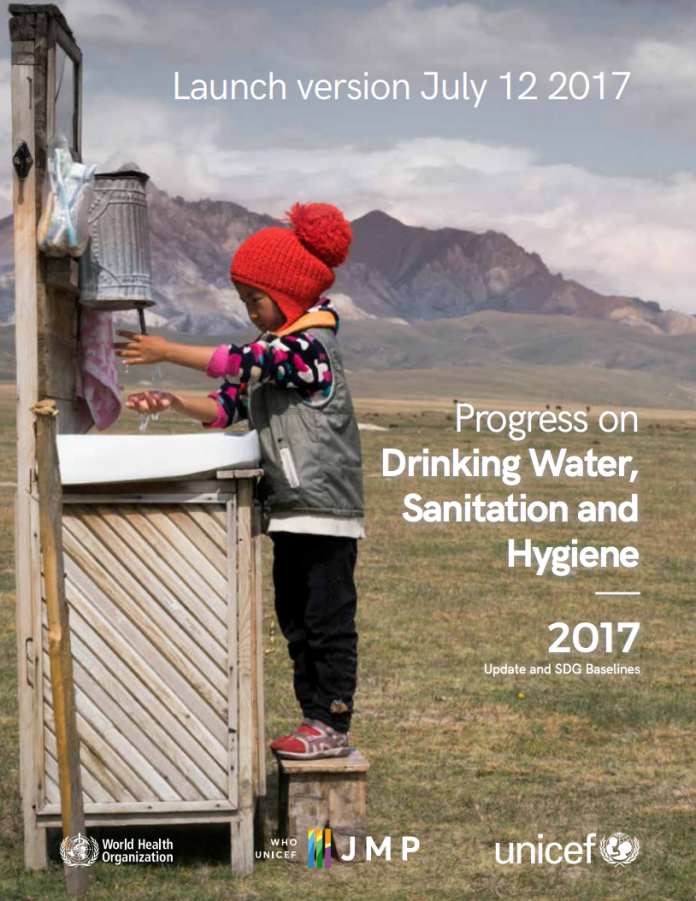WHO and UNICEF raise the bar in a new SDG report which focuses on the quality of water services. By Richard Johnston & Tom Slaymaker*
UN agencies just assessed the current state of human access to water, sanitation, and hygiene (WASH), with sobering results. Worldwide, 2.1 billion people lack safe drinking water at home; twice as many lack safe sanitation.
The higher estimates come from a more rigorous emphasis on the quality, not just quantity, of service delivery, making outcomes more inclusive from local to international scales.
The WHO/UNICEF Joint Monitoring Programme (JMP) 2017 update report sets baselines, targets, and indicators for WASH-related Sustainable Development Goals (SDGs) to, by 2030, ensure “the availability and sustainable management of water and sanitation for all.”
That WASH goal may now appear even more ambitious, thanks to the JMP’s most comprehensive global assessment to date. The report includes a wealth of new information on service levels, and raises the bar, estimating that 71 percent of humankind uses “safely managed” drinking water services. This upgraded definition–water free from contamination, available at home, on demand–means that at least 2 billion people still drink water contaminated with faecal bacteria, posing severe health risks, especially to children and the elderly.
Sanitation coverage becomes even lower. The JMP report estimates only 39 percent of people use “safely managed” sanitation services, defined as an improved toilet or latrine, not shared with other households, with a system in place to ensure that excreta are treated or disposed of safely. While 4.5 billion people lack safely managed sanitation services, those who do have safely managed services include 1.7 billion people living in urban areas where wastewater treatment plants provide at least some treatment, as well as nearly a billion people in rural areas who use latrines or septic tanks that allow excreta to be treated and disposed of on-site.
The numbers are sobering, but justified. The new focus on “safe management” highlights the systemic need to improve service delivery, enhance surveillance, and strengthen service regulations. For example, piped water supplies generally deliver better quality water than point sources. Yet pipes alone are still not enough, since in many places piped water is irregular and contaminated.
Governments need to know how many people drink water that meets UN standards, and can access water where and when they need it. Raising the bar will demand more of service providers, so they work to ensure water supply is regular, extend household connections to more people, and apply risk-based management approaches to prevent contamination.
Governments must also be able to rely on water quality surveillance programmes that extend all the way to the household tap, even though water quality problems may arise within the home, beyond the control of the service provider.
Knowledge is power. Governments with reliable information about drinking water services, often know far less about the management of excreta and wastewater. The baseline report draws on data on wastewater treatment from 115 countries, but in many cases the data included no information about compliance with effluent standards, or even the specific level of treatment.
All too often, treatment plants are overloaded or poorly designed, sewer lines discharge directly into nature, and wastewater never reaches a treatment plant. It is hard to quantify such system failures, but our reported estimate–that globally 73 percent of sewer-borne wastewater receives at least some treatment–is likely an upper bound. Even fewer data points were available on the treatment of excreta from on-site systems, despite their prevalence, including in many high-income countries.
By focusing on the quality of services, rather than just the absence or presence of infrastructure, the water and sanitation SDG targets become far more relevant to middle- and upper-income countries than their MDG predecessors.
Yes, some countries have already achieved near-universal access to basic services. But all countries have limitations regarding “safely managed” drinking water and sanitation services.
By emphasising outcomes rather than inputs, service providers and regulators play a pivotal role in achieving the 2030 SDG goal, of safe and affordable drinking water and sanitation for all.








